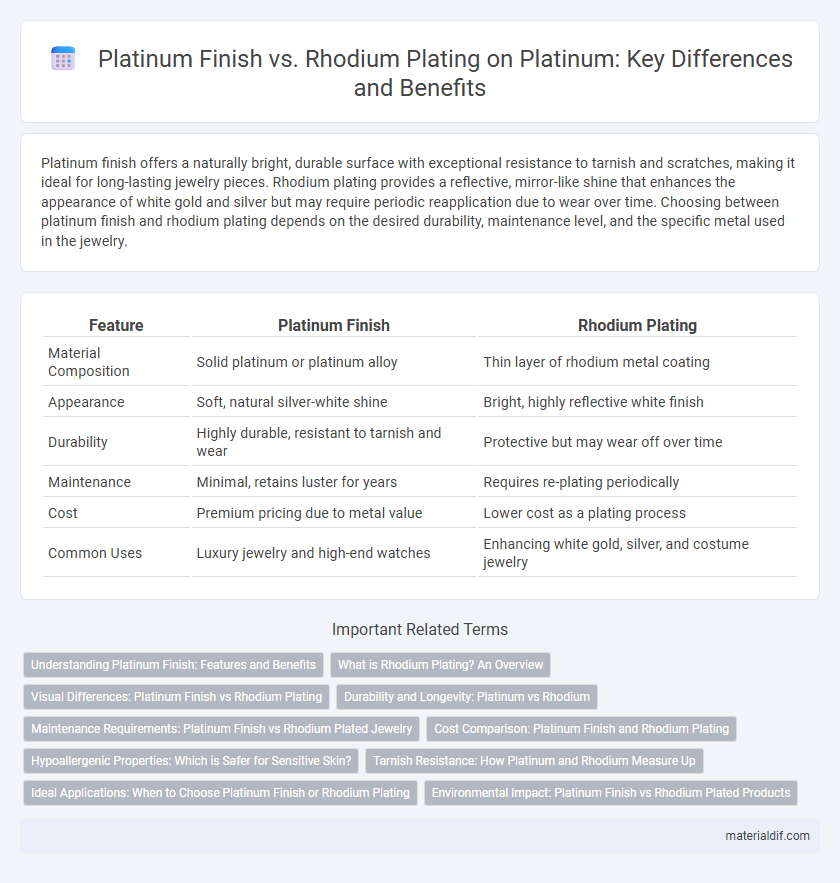Platinum finish offers a naturally bright, durable surface with exceptional resistance to tarnish and scratches, making it ideal for long-lasting jewelry pieces. Rhodium plating provides a reflective, mirror-like shine that enhances the appearance of white gold and silver but may require periodic reapplication due to wear over time. Choosing between platinum finish and rhodium plating depends on the desired durability, maintenance level, and the specific metal used in the jewelry.
Table of Comparison
| Feature | Platinum Finish | Rhodium Plating |
|---|---|---|
| Material Composition | Solid platinum or platinum alloy | Thin layer of rhodium metal coating |
| Appearance | Soft, natural silver-white shine | Bright, highly reflective white finish |
| Durability | Highly durable, resistant to tarnish and wear | Protective but may wear off over time |
| Maintenance | Minimal, retains luster for years | Requires re-plating periodically |
| Cost | Premium pricing due to metal value | Lower cost as a plating process |
| Common Uses | Luxury jewelry and high-end watches | Enhancing white gold, silver, and costume jewelry |
Understanding Platinum Finish: Features and Benefits
Platinum finish offers a durable, high-shine surface that resists tarnish and corrosion, making it ideal for fine jewelry and luxury watches. Unlike rhodium plating, which is a thin, white metal coating applied over other metals, a platinum finish consists of a solid layer of platinum that provides long-lasting luster and hypoallergenic properties. The benefits of platinum finish include superior scratch resistance, enhanced color retention, and increased value due to the precious metal's rarity and strength.
What is Rhodium Plating? An Overview
Rhodium plating is a process that applies a thin layer of rhodium, a rare and durable white metal, onto the surface of jewelry to enhance its brightness and resistance to tarnish. Compared to platinum finish, rhodium plating provides a reflective, highly durable coating that protects metals like silver and white gold from scratches and corrosion. This plating is popular for its brilliant, mirror-like finish and hypoallergenic properties, making it a preferred choice for fine jewelry maintenance.
Visual Differences: Platinum Finish vs Rhodium Plating
Platinum finish offers a luxurious, naturally white-metallic sheen with subtle warmth and a slightly matte appearance, while rhodium plating delivers a highly reflective, mirror-like brilliance with a cooler, bluish-white tone. The durability of rhodium plating tends to resist tarnishing and scratches better, preserving its striking brightness longer compared to the softer, more muted luster of a platinum finish. Visually, the choice between them depends on preference for either platinum's timeless elegance or rhodium's dazzling, modern shine.
Durability and Longevity: Platinum vs Rhodium
Platinum finish offers superior durability and longevity compared to rhodium plating, with its dense atomic structure resisting tarnish and wear over time. Rhodium plating, while providing a bright, reflective surface, typically requires periodic reapplication due to susceptibility to scratching and fading. Platinum's inherent corrosion resistance and robustness make it a preferred choice for long-lasting jewelry finishes.
Maintenance Requirements: Platinum Finish vs Rhodium Plated Jewelry
Platinum finish jewelry requires minimal maintenance due to its naturally durable and tarnish-resistant properties, often only needing occasional cleaning with mild soap and water. Rhodium plating, while highly reflective and resistant to scratches, tends to wear off over time, necessitating periodic re-plating to maintain its bright, white appearance. Both finishes offer protection, but platinum's maintenance is less frequent and more cost-effective compared to the upkeep of rhodium-plated jewelry.
Cost Comparison: Platinum Finish and Rhodium Plating
Platinum finish typically costs more than rhodium plating due to the higher price of platinum metal and the complexity of its application process. Rhodium plating offers a more affordable option, providing a bright, reflective surface with excellent tarnish resistance at a fraction of platinum's cost. Budget-conscious buyers often choose rhodium plating for its cost-effectiveness while still achieving a high-quality, durable finish.
Hypoallergenic Properties: Which is Safer for Sensitive Skin?
Platinum finish and rhodium plating both offer hypoallergenic properties suitable for sensitive skin, but rhodium plating tends to provide a more durable, tarnish-resistant layer that minimizes skin irritation risks over time. Platinum is naturally hypoallergenic, often chosen for its purity and resistance to allergens, making it ideal for prolonged wear without causing allergic reactions. Comparing the two, rhodium plating enhances the protective barrier on jewelry surfaces, while platinum's intrinsic hypoallergenic nature ensures safety for individuals with metal sensitivities.
Tarnish Resistance: How Platinum and Rhodium Measure Up
Platinum offers exceptional tarnish resistance due to its dense molecular structure and natural chemical inertness, which helps maintain its luster over time. Rhodium plating provides a brilliant, reflective surface with moderate tarnish resistance but tends to wear off faster than solid platinum, requiring periodic reapplication. Both metals enhance jewelry durability, but platinum's long-lasting resistance to tarnish makes it a superior choice for enduring shine.
Ideal Applications: When to Choose Platinum Finish or Rhodium Plating
Platinum finish is ideal for high-end jewelry pieces requiring long-lasting durability, excellent resistance to tarnish, and a unique, subtle luster, making it perfect for engagement rings and luxury watches. Rhodium plating suits white gold and silver jewelry that needs a bright, reflective surface and short-term protection against scratches and corrosion, often used in fashion jewelry and everyday accessories. Choose platinum finish for premium, maintenance-free elegance, while rhodium plating is preferable for cost-effective, frequent reapplication to maintain shine.
Environmental Impact: Platinum Finish vs Rhodium Plated Products
Platinum finishes often have a lower environmental impact compared to rhodium plating due to the more sustainable extraction processes and recyclability of platinum. Rhodium plating involves highly toxic chemicals and produces hazardous waste, increasing its ecological footprint. Choosing platinum finish supports eco-friendly practices by minimizing chemical waste and promoting metal reuse.
Platinum Finish vs Rhodium Plating Infographic

 materialdif.com
materialdif.com